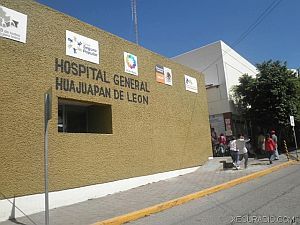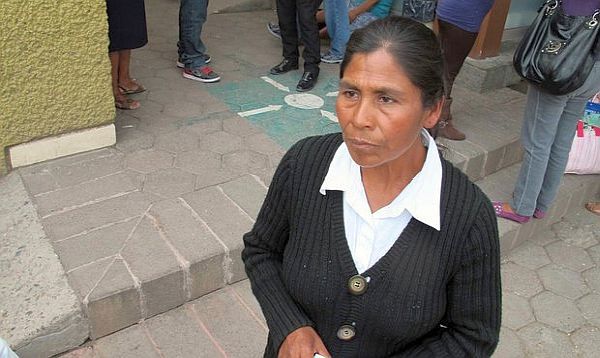Huajuapan De Leon, Mexico — The pangs were quickening when Nancy Salazar Lopez arrived at a hospital in the remote city of Huajuapan de Leon in Oaxaca one recent Sunday. She felt her baby was coming. But doctors did a cursory check and said she wasn’t ready. They asked her to return in a few hours. She did, again and again.
They kept turning her away, the last time after her water had already broken and blood dribbled down her legs. "They said there weren’t enough doctors," said Salazar’s mother, Jesus Ofelia Lopez Cisneros, a 47-year-old ethnic Mazatec, one of 15 major indigenous groups that live in the southern Mexican state.
Her daughter gave birth that evening on the hospital’s concrete steps, unable to gain entry. As the birth took place, a crowd gathered. The father swaddled the newborn in a cloth. A physician emerged after more than five minutes. "They were shouting at him. They said he was an idiot, that he should help her," Lopez said. The physician asked for forceps to clip the umbilical cord. A second doctor emerged and helped lift the mother onto a gurney.
The birth of Salazar’s child January 26th on the periphery of the main state hospital here is far from unusual. Seven times since mid-2013, women have given birth on the lawns or steps of hospitals or health clinics in the states of Oaxaca and Puebla. The cases are known largely because bystanders snapped photos or took videos, and later posted images on the Internet.
The cases almost always involve darker-skinned women - mostly indigenous, as Mexico’s native groups are known - and they’ve laid bare the discrimination that some patients say underlies Mexico’s health care system. A cardboard sign taped to the wall outside the General Hospital here says, "Enough of racism!" But the cases also expose shortcomings in policies that have swamped hospitals with routine pregnancies that could be cared for in health clinics or even at home with the help of midwives.
Spooked by the national publicity given to the cases in Oaxaca, the third poorest of Mexico’s 31 states, state Health Secretary German Tenorio Vasconcelos has said that he’s fired four physicians and suspended two in cases where pregnant women have been denied entry to clinics or hospitals.
 |
"I’ve said it to the secretary’s face: He is looking for scapegoats. These measures are totally oriented to the media," said Paola Sesia, a US educated medical anthropologist who works at the Oaxaca branch of the Center for Research and Advanced Studies in Social Anthropology.
After being turned away three times over a period of seven hours, a pregnant 16-year-old gave birth last week in a car outside the clinic in Salina Cruz, a Oaxacan port. The physician in charge was immediately suspended.
The case of another young Mazatec woman raced across the Internet in early October. When Irma Lopez Aurelio went to a state health clinic in the town of Jalapa de Diaz, personnel wouldn’t admit her, saying no doctor was available. Photos later showed a grimacing Lopez, wearing a maroon print dress, dropped on one knee, with her newborn son, Sabino, on the grass on clinic grounds.
Lopez’s husband, Margarito Andres Velazquez, later complained of how long it took state health officials to acknowledge that they’d mistreated his wife, and that happened only after a team from one of Latin America’s largest television networks showed up. "The cameras from Univision arrived before the secretary of health," he told reporters.
Cameras in cellphones have, indeed, highlighted the treatment of indigenous women at hospitals across Mexico, bringing to light conditions that were barely noticed before. Maria del Carmen Oseguera, 21, gave birth on the waiting room floor of a women’s hospital in Tehuacan, in Puebla state, on September 7th 2013.
 |
The quasi-official human rights defender in Oaxaca state, Arturo Peimbert Calvo, said of such videos, "Technology has turned into an ally in providing testimony of violations of human rights." While some activists chalk up such cases to racial discrimination, other experts say that more complex factors come into play, including attitudes of superiority by medical personnel toward poorer patients, especially women who speak an indigenous language.
"The women arrive and say, ‘I’m about to give birth.’ They say, ‘No, you’re not ready yet,’" said Maria Cristina Galante of Nueve Lunas, a nonprofit advocacy group for maternal health in the Oaxacan capital. "The doctors speak to them in medical terms – ‘Your cervix isn’t fully dilated’ – and the women don’t understand," said Ana Maria Hernandez, a women’s rights activist and the head of the nonprofit Consortium for Parliamentary Dialogue and Fairness in Oaxaca.
The state has seen dramatic changes in the way maternal health care is provided over the past three decades. In the 1980s, more than half of births took place at home, usually in rural areas, attended by midwives.
After a 1983 constitutional amendment gave every Mexican the legal right to health care, state governments began to react. By the early 2000s, eager to reduce maternal mortality rates that were nearly double the national average, Oaxaca mandated that all pregnant women should give birth in health clinics or hospitals.
Since then, clinics and hospitals have been flooded with pregnant women, without a corresponding increase in personnel. At rural clinics, sometimes only a newly graduated physician completing mandatory public service is on call, and wary of mishandling patients. "They are all afraid of the repercussions because if there is a maternal death, it’s on their hands," Galante said.
So they often send women on to the state’s 40 or so hospitals - either under state or federal administration - where doctors, if swamped, may take advantage of a quota that allows them to say cesareans are needed and pass them along to private hospitals, where many doctors also work on their off hours.
When pregnant women are referred to the private hospitals, the state reimburses doctors the equivalent of $1,750 for the caesarean, an incentive. "Almost no one talks about this because it touches on the mafia that surrounds health policy," Galante said. Still, many pregnant women find themselves pacing outside hospitals or sitting in waiting rooms, waiting for admission.
Angel Sanchez, a 27-year-old day laborer whose wife gave birth on the hospital steps in this city, said there were about three other pregnant women waiting for spots ahead of his wife when "she suddenly said, ‘I can’t take it anymore.’"
Sanchez said medical personnel had told all the women to pace the sidewalk to speed contractions. "There are many women suffering outside because they don’t want to see them inside," Sanchez said.
Original Story


